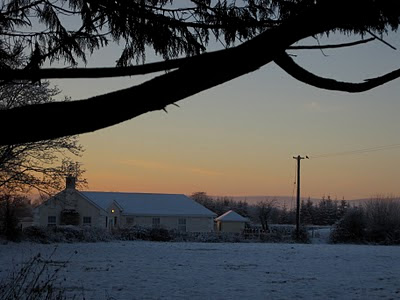An Irish Country Christmas
An Irish Christmas in the snow covered countryside was what I envisioned and what I experienced—a snuggled old dog in front of a warm fireplace, simple home cookin’ of spouts and potatoes, quiet company and Christmas crackers. I spent four days with the Fitzell family in Portlaoise and two days in Dublin City.
I attended Christmas mass with Margaret, Hollie and Rebecca while Sean cooked Christmas dinner. My eyes enjoyed seeing a more simple church, barren and beige compared to the ornate and over the top décor of Spanish cathedrals; it was beautiful in its simplicity. My favorite part was looking around at all the people—the fair skin and dark hair, and all light-eyed, with the occasional Ginger kids—red freckled and for surely the poster children for all things Irish.
 Grandma Betty bought us all Christmas Crackers, a British holiday tradition that The Fitzell family couldn’t believe I’d never seen, nor pulled. And Rebecca’s sixteen-year-old sister Hollie was quick to explain the process. Two people pull on a large paper tube, the one with the luck or better technique gets the whole of the cracker as it pulls apart—“CRACK!” and a paper hat, kazoo, and joke fly out. We entertained ourselves most of the afternoon playing “Name that Tune” with our kazoos, parading around in our gold paper crowns.
Grandma Betty bought us all Christmas Crackers, a British holiday tradition that The Fitzell family couldn’t believe I’d never seen, nor pulled. And Rebecca’s sixteen-year-old sister Hollie was quick to explain the process. Two people pull on a large paper tube, the one with the luck or better technique gets the whole of the cracker as it pulls apart—“CRACK!” and a paper hat, kazoo, and joke fly out. We entertained ourselves most of the afternoon playing “Name that Tune” with our kazoos, parading around in our gold paper crowns.Easy Living
The Irish, like the Spanish, seem happier with less. The Fitzell home is beautiful, it is nice, and it is old. The rooms aren’t redecorated and up to the latest fashion. The curtains and the carpet, are quaint and country, there’s no need for improvement if it works just fine. I noticed this, the simplicity of everything—the home, the meal, the days—and I admire it. There is no burning need for more more more. It felt calmer. It felt smaller. Less wasteful. I enjoyed the simplicity of the family, the five us around the table, watching movies, just being together. Margaret turned on my bed’s electric blanket every night before bed. Uncle Billy gave me a Seamus Heaney book of poetry. Sean made me oatmeal every morning and Grandma fed me Christmas chocolates out of a tin. Hollie, Rebecca, and I walked through the snowy fields with horses and were triplets in our matching Christmas Eve pajamas.
The Irish are perhaps the friendliest people I’ve met. The cab drivers, store clerks, the fellow bus passengers—their sense of humor is exceptional and unmatched. They are jolly, they are funny—smart-ass and sarcastic—and always “down to have the craic.” Craic, pronounced crack, is the word for the Irish. It means fun. And it fits perfectly into most situations, as most of the time the Irish are in the pub, “just having the craic.”
Irish Cuisine
I ate cream covered jelly trifle, Fish and Chips, oatmeal, rum cake, and drank a great many cups of tea. The Irish cuisine is distinct from the Spanish, I would say mostly in the difference of olive oil and in fish. Where Ireland is potatoes, butter and salt, Spain is ham and olive oil and bread.
 The best thing I tasted on the Irish leg of my adventure? Guinness. Hands down. I poured my own pint at the Guiness Storehouse, sat in the bar overlooking the city, and had the craic. The thick drink is so rich and satisfying. The beer has the dark flavor and heaviness that you might find in coffee, but the crispness is refreshing, and the smooth creamy head makes it completely unique. The Guinness in the factory surpasses the pints poured in the pubs of Dublin and obviously stands miles above the Foreign Export we drink in the States. I am spoiled now, because when you have the best, nothing else is ever good enough. No pint of Guinness will ever compare. December 28th was Rebecca’s seventh time visiting Guinness, she brings all her foreign friends, and it doesn’t get old. She knows it is something as important as the Saint Patrick’s Cathedral or Trinity College. The culture is so based upon a brewery—a beer that literally symbolizes a nation.
The best thing I tasted on the Irish leg of my adventure? Guinness. Hands down. I poured my own pint at the Guiness Storehouse, sat in the bar overlooking the city, and had the craic. The thick drink is so rich and satisfying. The beer has the dark flavor and heaviness that you might find in coffee, but the crispness is refreshing, and the smooth creamy head makes it completely unique. The Guinness in the factory surpasses the pints poured in the pubs of Dublin and obviously stands miles above the Foreign Export we drink in the States. I am spoiled now, because when you have the best, nothing else is ever good enough. No pint of Guinness will ever compare. December 28th was Rebecca’s seventh time visiting Guinness, she brings all her foreign friends, and it doesn’t get old. She knows it is something as important as the Saint Patrick’s Cathedral or Trinity College. The culture is so based upon a brewery—a beer that literally symbolizes a nation. 


No comments:
Post a Comment